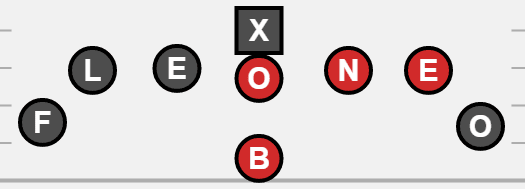This is a common technique in nowadays under-center Veer teams on the college level. It is easier to teach than the Ride and Decide Method because less parts are moving during the procedure. It helps reading the stunts and estimating the movement of the defense. This is because of the principle of relative velocity. Estimating a cars speed from the sidewalk is easier than judging it from your car moving in the opposite direction.
The Quarterback steps with his playside foot (right foot if going to the right) to 5 o'clock and brings his backside leg (left leg) almost simultaniously parallel to the B-Backs path, creating a hopping motion on this step. He has to bring both feet into the ground as quick as possible, keeping his legs bent and keeping the shoulder level low. With the hopping action, Quarterbacks tend to raise up more and this has to be limited. Because there is no pushoff, the depth will be closer to the line of scrimmage than on the Ride and Decide Method. It is really important that the feet are parallel to the path of the B-Back, otherwise fumbles will occur. The ball will be pushed back with the extended front arm (left arm) similar to the Ride and Decide Method, tucking his chin to the front shoulder (left shoulder) and getting his eyes on the Divekey. His feet will be flatfooted and he will start the ride off this stance. The weight transfer starts toward the front foot (left foot) and the decision has to be made at the front hip, not reaching out. The read is shorter than on the Ride and Decide Method because of the flatfooted stance and tough on certain stunts. After the ride, the Quarterback has to start from a stationary position and needs to get off fast. If the Quarterback is not athletic enough the backside can chase down the Quarterback from behind.
Coach Tony DeMeo has used a different technique for his Gun Triple Option. Basically the Fullback is utilized as an additional blocker in pull reads and cuts the Divekey. Currently the technique is not common with Flexbone Offenses but a lot of phrases he uses apply to it perfectly. More on that in a separate article.
